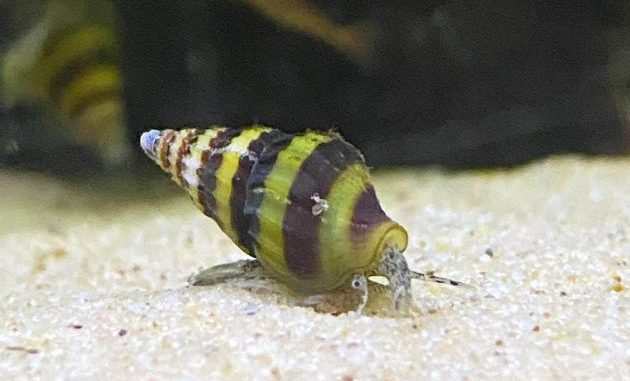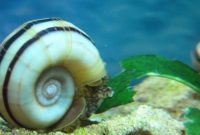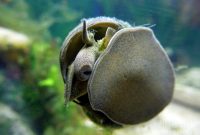Assassin Snails Care – Are you having pest snails problems in your tank? They make the most of aquarists going frustrated. But, don’t worry, you have come to the right place. This article will share one solution to get rid of the pest snails using another snail specimen. Keep reading, OK!!!
The pest snails usually prey on live aquatic plants and consume more invertebrates foods, especially sinking or clipping wall pellets. It’s very harmful, make our beloved plants die slowly and starving our helpful shrimps and snails.
Controlling them are slightly difficult. The faster reproduction behavior of the pest snails can generate many snails only in a few days. It means they will need more food to survive and produce more dirt. Without we say, you surely know if it will pollute your aquarium.
Don’t be discouraged; there is a natural creature that becomes their predator in the wild. Assassin snails (Clea Helena/Anentome Helena) are the natural killers that can help you remove all pest snails in your tank.
They are freshwater snails type that belongs to the family of Buccinidae. These aquarium snails, also known as bumblebee snails, this nicknames based on their shell pattern appearance.
Assassin snails often sell in trades as biological agents that eat most aquarium pest snails, such as ramshorn snails, pond snails, bladder snails, and Malaysian trumpet snails. A single Clea Helena usually will rate about $2 and getting cheaper if you purchase some snails at once.
This article will guide you to keeping the assassin snails in the right way and make them useful in the tank. This talk is about how to care, diet, tank setup, breeding, and more.
Clea Helena The Assassin Of Aquarium Pest Snails
Origins And Natural Habitats Of Assassin Snails
Assassin snails are a member of whelks/true whelks (sea snails) and adapted to live in freshwater environments. These aquatic snails varieties can be found across Southeast Asia, including Thailand, northern Peninsular Malaysia, Vietnam, Laos, Cambodia, and Indonesia.
These specimens inhabit almost of varieties of freshwater habitats that mainly the areas that have a soft substrate. These places usually including rivers, streams, lakes, ditches, agricultural water sources, ponds, reservoirs, and canals.
Read Also: 5 Effective Ways To Get Rid Of Ramshorn Snails In The Aquarium
Assassin Snails Appearances
Bumblebee snails are relatively smalls like other aquarium snails. Adults typically grow up to 1-inch size, but they can grow more significantly depending on their meals. Wild types tend to have bigger bodies than the snails that captivity breed forms.
These pest snail-eaters have shells like a cone/trumpet with dark brown and yellow lines that run around it. They have a pretty thick shell with 5-6 whorls spiral, and you can see many lateral ridges through there. A part of the shells tends to wear away when the snails go older, and it is the apical part. Some specimens may have plain dark brown color without spirals yellow stripes over their shell, but it is rare.
Another exciting part of the shell is the operculum that known as “the trap door.” It is has a brown color and functions to close off the shells when the snails feel dangerous; they will hide inside soon.
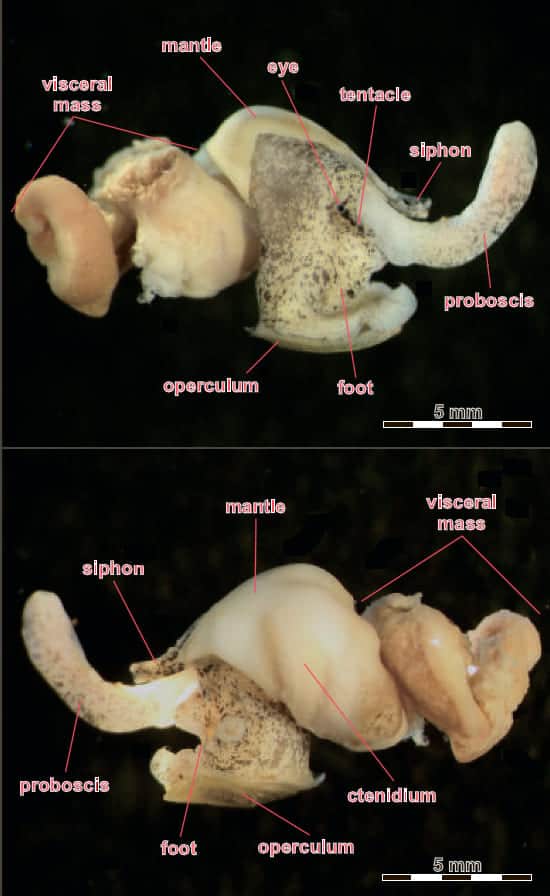
This part will fall when the assassin snails die. If there is something wrong with your snails, the shell will not close properly. So, this part is a simple way to identify they are healthy or not.
The actual bodies part of them is yellowish with grey dots all over. Their mantle shapes a foldable tube. Clea Helena’s siphon is equipping with chemoreceptors which are like in most snail scavengers or predators species. Its uses are to perceive water and find the foods at a distance.
Their siphon is strong and acts as a multipurpose water sampling tool; This part is created from an elongated left mantle edge fold. The siphon also has another work as a snorkel (breathing tube) when these snails are buried.
Another thing that is interesting to discuss is their foot. They have a muscular and robust foot that is relatively thin and translucent (propodium). The functions of their muscles are to moving the snails forwards at a very slow rapidity. The foot also helps them to climb, to burrow, and capture a portion of food.
Assassin snails have a head equipped with a pair of mobile tentacles that are can be partially retractable. This part is very sensitive, also helping them when exploring the aquarium and searching for food.
At the base of tentacles, there is a pair of eyes. According to some researchers’ information, their eyes can only see the diversity between dark and light. They also do not use their vision during hunting.
Under the optimal conditions with enough nutritious foods supplies, assassin snails could live around 5 years.
Read Also: How to Stop Green Dust Algae Growth In An Aquarium
Assassin Snails Behavior And Temperaments
Bumblebee snails are extremely slow movement, so they would not show many activities in your aquariums. You may see them infrequently during the day because they choose to do more activities during the night, such as hunting for a snack.
These pest snails killers will stop this habit when they sense you feed them in the daytime. They will appear soon and go straight to the food.
Assassin snails commonly spend almost all their time buried themself in the substrates, especially during the daytime. It does not mean they are resting or sleeping. This habit is just the way they hunt prey by waiting for them moves above their body.
Clea Helena is not social species; they prefer to act by themselves. But, they can work together with other assassin snails if they feel interested in attacking a giant snail.
In my experience, they can become aggressive and cannibalistic if there is no available food in the tank and they feel so hungry. My little assassin snail becomes a victim by the large one. They also eat my nerite snail and poor cherry shrimp. So, when your tank is clean from the pest snails, move them immediately to a separate tank to avoid this incident.
Read Also: Are Axolotls Good Pets For You? It’s A Complete Guide Of Keeping, Feeding, Behavior, Characteristics
Hunting Methods Of Assassin Snails
Their hunting styles depend on how hungry they are. They can hunt actively or tend impassively by waiting for the prey to come (ambush tactic). If they are not hungry, the bumblebee snails usually bury themselves under the substrates as a prevention against the predators such as pufferfish, crabs, and crayfish.
Assassin snails often spend several hours burying themselves in the substrates before they feel hunger. And, when the prey is near around them, they are ready to attack immediately.
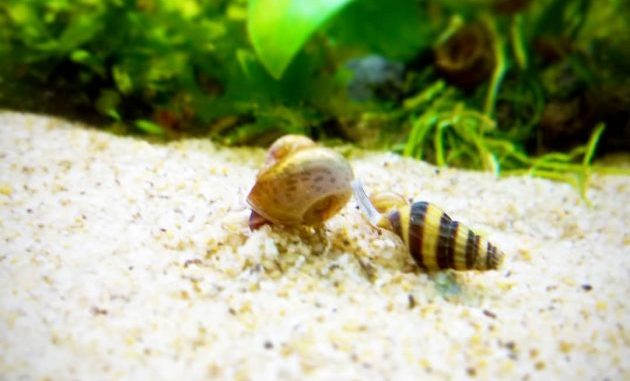
Buy The Assassin Snails Only On Amazon
Keeping these aquatic snails, you will see their extended proboscis when exploring the tank to hunt food. Once they get prey, assassin snails will grip with their foot and suck the prey bodies using proboscis while it’s still alive.
Some reports talk if these snail predators use a toxin or venom to paralyze the pest snails or prey. But until now, we did not found any scientific research to confirm this statement.
Bumblebee snails are actually strong enough to defeat the prey by their strength, although the prey is larger. Even though the snails (prey) have a trapdoor, they still could peel open it using their proboscis.
Read Also: COMPLETE Blackwater Fish Tank Setup Guide
Assassin Snails Housing, Tank Setup, And Care
The minimum tank size for assassin snails is 5-gallon (20 litter). And, how many assassin snails per gallon? There is no valid data about that. But, most aquarists usually use 2-4 assassin snails for a 10-gallon tank depending on how many numbers of pest snails inhabit there.
Using sandy and soft substrates such as “Fluval Black Sand” is preferred by them. It will help them quickly bury themselves underneath. You can also use a soil substrate form.
Creating their natural habitat by adding aquatic plants such as anubias species, cryptocoryne, Bolivian sword, and more makes them grow healthy. Don’t worry, assassin snails are not interested in biting them.
Add some decorations like caves, wood or stones is unnecessary. But, putting it gives the snails space to exploring, climbing, hiding and provides a place to stick their eggs.
The tank must have an excellent filtration system to keep the water quality. You can also equip it with a heater to stabilize the temperature. It will give additional value to snails growth.
There are no specific requirements for the lighting system because they can live well under various radiation types. It should be adapted to aquarium plants’ needs. Assassin snails also can live in a much different water flow, so you can set it whatever you want.
Bumblebee snails shells are made from 95–99.9 % calcium carbonate. If the pH water is low, it can dissolve calcium carbonate that contains in their shells. It will scrape their shell and leave a hole, making them in dangerous conditions around other species such as fish.
Ideally, the water does not too be acidic and/or soft. Here is the appropriate water parameter for assassin snails to thrive better in the aquarium:
- Temperature: 75 – 82 degrees Fahrenheit (24–28 degrees Celcius)
- pH level: 7.0–8.0
- KH level: 2–10
- GH level: 6 – 20
- Nitrate: <20
Like the fish, assassin snails also can get a disease in the aquarium. You should find a way to treat the assassin snails’ illness and take care of them with love to preventing it comes again.
Sometimes their shells are susceptible to affect by several problems. For example, they may display some white spots sticking across their shells. It is perhaps a parasite that attaches to the outside of the shells. And there are several kinds of parasites that survive by use snails bodies parts.
Adding aquarium fertilizers that contain calcium or calcium supplements is essential to maintain their shells in better condition. But, the best is to give them some food that contains rich calcium substances. Because it’s will be critical if the shells are weakening, it could crack and crush.
If the water temperature is lower and the available foods are not enough for them, the snail shell’s growth level may be too slow. Regular water change every 1-2 weeks keeps the water quality balance and keeps the nitrate at a low level because they are also susceptible to poor water quality.
The one substance that must go away from the tank is “cooper.” It’s toxic that very unsafe for most invertebrates species, including assassin snails. You should always check any contents which you add to the aquarium. Some medicines commonly contain several percent of cooper compound.
Read Also: 10 Good Reason Why You Should Have An Aquarium Fish At Your Home
Assassin Snail Tankmates
These aquarium snails species can live together with most of the peaceful fish types. The small fish which often swim around the middle level of tanks such as platies, guppy, neon tetra, and cherry barb becomes a perfect option.
Calm larger fish varieties such as pearl gourami, dwarf gourami, angelfish, and discus also can be their friends in the tank. A fishkeeper tells us if they could keep with betta fish. These fish known can live in peace with more giant snails like apple snails. The peaceful bottom-dwellers fish types like corydoras and otocinclus can be kept together with them too.
Almost most of the mollusks varieties, although having huge sizes are not safekeeping with assassin snails. Dwarf shrimps types should not be put with them, such as cherry shrimp. The larger species like bamboo shrimps may be lived together with them.
Never try to add pufferfish, loaches, goldfish, cichlids, and other aggressive/big species, or they will become their snack. Crabs and crayfish also must be avoided; they are natural predators for all of the snail varieties.
Read Also: The Easiest Aquarium Plants For Beginner Aegagropila Linnaei Known as Marimo Moss Balls
Assassin Snails Feeding And Diet
The bumblebee snails are carnivorous. They will refuse all aquatic vegetation, including algae, different from other usual aquarium snails. Their favorite foods are pests snails (ramshorn and Malaysian trumpet snails), snail eggs, fish eggs, and shrimps fry.
Live and frozen foods could be a good choice for them. You can try feeding them with blood worms, brine shrimps, or frozen meat shrimp. Sometimes they also accept sinking pellets, flakes, and algae wafers, but this varies by individual.
Generally, a single mature assassin snail can eat 1-2 pest snails per day. Typically, they do not eat their own eggs or young snails. But in certain conditions, they may predation them.
Assassin Snails Breeding
The Clea Helena is quite easily breeding in captivity. Though you are a beginner, you could handle them when reproducing. Unlike most of the gastropods species, they are not hermaphrodites. So, you need a male and female to spawn them. It’s a benefit for you to simply controlling their number in your tank.
Distinguishing their sexes is hard; both of the sexes are very similar. To increase the success of chances is to keep these snails in a group of around 6 or more individuals.

Before the breeding section, a pair of assassin snails will follow each other around the tank for about 12 hours or more. When the courtship part starts, the male will climb the female’s shell and hold it tightly for a duration between 20-30 minutes. After that, the male will slightly move the right side of the female body and begin to spawn.
This process takes about 3-5 hours and usually happens at nighttime. Once the mating activity is over, the females and males will be separated. She will lay the little eggs above the heavy surface such as aquarium wall, aquatic plants, rocks, and driftwood, probably to protecting them.
Eggs will hatch after 20-30 days. The juveniles Clea Helena will bury themselves underneath the substrates till they’ve grown. You may not see the snails again until they have adults (around 6 months).

